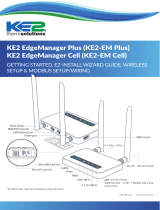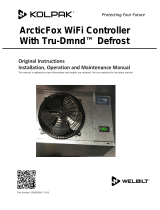
Low Velocity Evaporator Coil
Sensor Location Guide for Air & Coil Sensors
Q.1.39 December 2021
Page 2
© Copyright 2021 KE2 Therm Solutions, Inc., Washington, Missouri 63090
Q.1.39 December 2021 supersedes all prior publications.
KE2 Therm Solutions
12 Chamber Drive . Washington, MO 63090
1.888.337.3358 . www.ke2therm.com
Coil Sensor Location
Low velocity style coils present a unique challenge due to their construction.
It is typical for these style evaporators to consist of 2 separate evaporator coils,
fed by a common expansion valve. This conguration creates a larger potential
for inconsistent frost patterns. Consequently, extra care must be taken when
locating the coil sensors. KE2 Therm highly recommends using two coil sen-
sors, on these types of coils.
As with any installation using KE2 Therm controllers, the proper location for
the coil sensor is where frost on the evaporator coil disappears last, dur-
ing a normal defrost cycle. The most eective way to determine this location
is to place the system into a defrost cycle. By watching the frost pattern, and
how it disappears on your specic coil, the system itself will indicate precisely
where the ice disappears last.
Electric Defrost – For electric defrost, sensor location is generally easy to
identify. If the heaters are mounted to the bottom of the coil, then the sensor
should be mounted near the top of the coil, using a vertical orientation. See
below.
Air Defrost – Medium Temperature coils, utilizing an o-cycle defrost, use the
air in the space as the defrost heat source. The proper location for the sensor is
typically on the air exiting side (outside) of the evaporator.
NOTE: Whether the evaporator is utilizing Air or Electric Defrost, it is essential
for the installer to leave a service loop long enough for the sensor to be relo-
cated anywhere along the evaporator. This provides exibility to make adjust-
ments if necessary.
Coil Sensors
(two places)
End View
Defrost Heat Source
(typically bottom only)
Side View Typical locations for coil sensors
The absolute best spot? Let the system show you. The spot where
ice disappears last during defrost is the ideal coil sensor location.
Often the best spot is on the valve side of the evaporator.
Note, the most active portion of the sensor
is the rst 1/2” of the 1-1/2” long stainless
steel probe.
Installing the Coil Sensor
Coil Sensor Operation
Once the ideal sensor location is determined, the controller will bring that
spot to termination temperature each and every defrost, and ensure the en-
tire evaporator is clear of ice. When the controller restarts refrigeration after a
defrost cycle, it now knows there is no remaining ice on this evaporator.
Warning Signs
If for any reason the controller cannot reach the termination temperature it
will warn you “Defrost Terminated on Time Not on Temperature”. The con-
troller is telling you that something is wrong, the system needs to be checked.
Basically it is saying, “I’m running, but I can’t clear my coil. Please help.”
Alternate method – As the defrost termination sensor, it is important to en-
sure the sensor does not terminate defrost before all frost has been removed
from the coil. In some installations, inserting the sensor into the coil may posi-
tion it too close to the defrost heat source. An alternate method of positioning
places the sensor vertically between the coil ns. This shows the coil sensor
properly secured.









